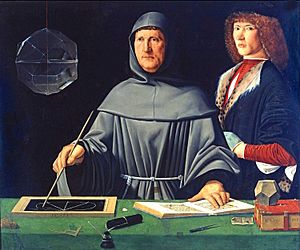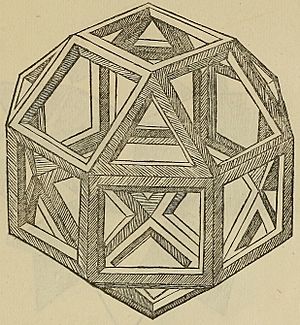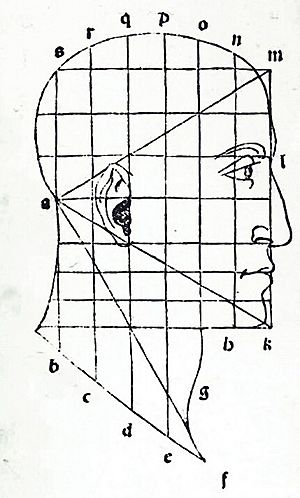Luca Pacioli facts for kids
Quick facts for kids
Luca Pacioli
|
|
|---|---|

Portrait of Luca Pacioli, traditionally attributed to Jacopo de' Barbari, 1495
|
|
| Born | c. 1447 Sansepolcro, Republic of Florence
|
| Died | 19 June 1517 (aged 69–70) Sansepolcro, Republic of Florence
|
| Citizenship | Florentine |
| Occupation | Friar, mathematician, writer |
| Known for | Summa de arithmetica, Divina proportione, double-entry bookkeeping |
Fra Luca Bartolomeo de Pacioli (born around 1447 – died June 19, 1517) was an Italian mathematician and a Franciscan friar. He is often called the "Father of Accounting." He was the first person to publish a book about the double-entry system of bookkeeping. This system is still used today by businesses all over the world.
Pacioli also worked with the famous artist and inventor Leonardo da Vinci. He was known as Luca di Borgo because he was born in Borgo Sansepolcro, Tuscany. Some of his works used ideas from other mathematicians without giving them credit.
Contents
His Life Story
Luca Pacioli was born in the town of Sansepolcro, Italy, sometime between 1446 and 1448. As a child, he received an "abbaco education." This type of schooling taught practical math skills in the local language, not Latin. It was very useful for merchants and traders.
Around 1464, Luca moved to Venice. There, he tutored the three sons of a merchant. During this time, he wrote his first book, which was about arithmetic. Between 1472 and 1475, he became a Franciscan friar, which is why he was called "Fra" (Friar) Luca.
In 1475, Pacioli began teaching mathematics in Perugia. He wrote a detailed textbook for his students. In 1494, his important book, Summa de arithmetica, was published in Venice.
In 1497, he was invited to work in Milan by Duke Ludovico Sforza. This is where he met Leonardo da Vinci. They lived and worked together, with Pacioli teaching Leonardo mathematics. In 1499, they had to leave Milan when the city was taken over. Pacioli likely spent his final years in Sansepolcro, where he passed away around 1517.
His Math Works

Pacioli wrote several important books about mathematics:
- Tractatus mathematicus ad discipulos perusinos (written 1477–1478): This was a long textbook for his students at the University of Perugia. It covered merchant arithmetic, like how to calculate profit and exchange money.
- Summa de arithmetica, geometria. Proportioni et proportionalita (published 1494): This book was a summary of all the math knowledge of his time. It was the first printed book on algebra written in the common language of the day. It also included the first detailed description of the double-entry accounting system. This system was used by merchants in Venice during the Italian Renaissance.
Pacioli's accounting system showed how to use journals and ledgers. He advised that a person should not go to sleep until their "debits" (money coming in) equaled their "credits" (money going out). His ledger had categories for assets (what a business owns), liabilities (what it owes), and expenses. He also showed how to close accounts at the end of the year. This book was used as an accounting textbook for many years.
- De viribus quantitatis (written 1496–1508): This book was about math and magic! It was the first book to mention card tricks. It also gave tips on juggling, eating fire, and making coins "dance." It was also the first book to note that Leonardo da Vinci was left-handed. This book was never published during Pacioli's lifetime. It was rediscovered much later and translated into English in 2007.
- Geometry (published 1509): This was Pacioli's translation of Euclid's famous book, Elements, into Latin.
- Divina proportione (published 1509): This book was about mathematical and artistic proportion. It especially focused on the golden ratio and how it was used in architecture. Leonardo da Vinci drew the amazing illustrations of geometric shapes for this book. These drawings were some of the first to show skeletal shapes, making it easy to see the front and back.
Using Others' Ideas
Some parts of Pacioli's books, like his Summa de arithmetica and Divina proportione, included ideas and translations from the works of another mathematician, Piero della Francesca. Pacioli did not always mention Piero della Francesca as the source of these ideas. This led to some debate and criticism from historians later on.
His Influence on Business
Pacioli had a huge impact on how businesses keep track of their money. By clearly describing the double-entry accounting method, he helped businesses become more organized and efficient. This system allowed them to better understand their finances and make more profit.
The accounting section of his Summa book was used as a textbook around the world for many years. The basic ideas of double-entry accounting have stayed almost the same for over 500 years. People who work in accounting today owe a lot to Luca Pacioli for his important role in developing this system.
You can see some of Luca Pacioli's original books online. The ICAEW Library has his complete works, and the British Library has an interactive tool called "Turning the Pages" where you can view parts of Summa de arithmetica and Divina proportione.
Chess and Other Interests
Luca Pacioli also wrote a book about chess called De ludo scachorum (On the Game of Chess). For a long time, people thought this book was lost. But in 2006, a copy of the manuscript was found in a library in Italy.
Because Leonardo da Vinci worked closely with Pacioli and drew for his other books, some experts believe Leonardo might have drawn the chess problems in this manuscript or even designed the chess pieces shown in it.
See also
 In Spanish: Luca Pacioli para niños
In Spanish: Luca Pacioli para niños
- List of Roman Catholic scientist-clerics



